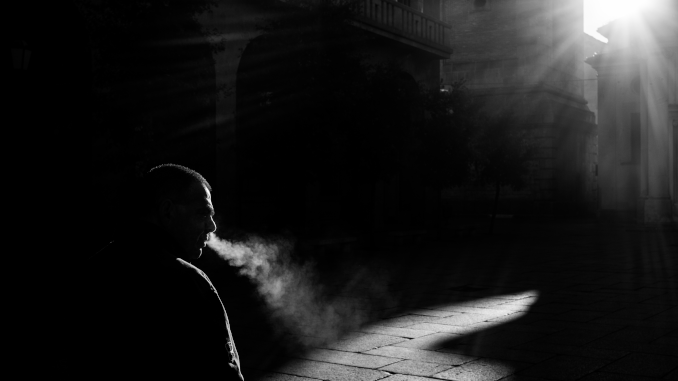
Today’s picture is 1957’s “The Strange One,” starring Ben Gazzara (Cadet Sergeant Jocko De Paris), George Peppard (Cadet Robert Marquales), Arthur Storch (Cadet Simmons), Pat Hingle (Cadet Harold Koble), James Olson (Cadet Roger Gatt), Paul E. Richards (Cadet Perrin “Cockroach” McKee), Geoffrey Horne (Cadet George Avery, Jr.), Larry Gates (Maj. Avery), Clifton James (Col. N. M. Ramsey), Mark Richman (Cadet Col. Laurie Corger), Julie Wilson (Peonie aka “Rosebud”). Directed by Jack Garfein; Director of Photography (Cinematographer) Burnett Guffey. Produced by Sam Spiegel; distributed by Columbia Pictures. Screenplay by Calder Willingham, from his novel and play “End as a Man.”
Here’s the film’s trailer, so you can get a sense of the look and feel of the movie, as well as what the story’s about:
The story opens in a fictional (*cough* The Citadel *cough*) Southern Military College, where two upperclassmen — Jocko De Paris and Harold Koble — enter the room of a couple of freshmen — Simmons and Marquales — in order to haze them. The four are soon joined by Roger Gatt, whom Jocko is setting up to get taken at a rigged game of poker. This ends with Jocko engineering events so that Gatt is beating Simmons with a broom.
In the next room, Cadet George Avery overhears what’s happening and goes to report the hazing incident to the detail on night duty, which includes his father, who’s on the school faculty. But when the group goes to investigate, everyone is in their proper room, and all seems normal. Col. Avery berates his son for making a false report.
Later, Jocko pulls Gatt out of the closet he was in (it seems like he must’ve been pushed in there while drunk to get him out of the way when the watch came ’round to investigate — as if there isn’t a more obvious signal to the homoerotic themes of this movie than dragging someone out of a closet — and the hazing resumes. When Cadet Avery overhears this, rather than go back to the watch, he instead goes into the next room, where he’s grabbed and beaten to a pulp.
The next morning, all the cadets report to the quad for reveille, whereupon Cadet Avery is discovered, face down underneath a tree, beaten, reeking of alcohol, and surrounded by empty liquor bottles. Jocko and Koble begin the rumor that Cadet Avery got drunk the previous night and then fell down a flight of stairs, somehow dragging himself onto the quad before collapsing under the tree. The cadets are told that anyone with information as to what happened needs to come forward. So Jocko does, claiming that he believes Cadet Avery suffered a mental breakdown over the belief he had that Jocko was persecuting him.
Now if you’re wondering how someone got drunk, fell down a flight of stairs, and then had all these intact empty liquor bottles lying around his body the next morning; then congratulations, because you, too, spotted the logic flaw here. If he was drunk enough to fall down the stairs, the bottles would either have been left upstairs or would’ve been broken in the fall, leaving broken glass as evidence, right?
Yeah, that never occurred to anyone investigating this…
Once the State Police confirm Cadet Avery had alcohol in his blood, he’s kicked out of school, and his father is angry, knowing things aren’t as they seemed. At some point, he tries to bully Jocko into confessing what he’s done, but Jocko manages to turn the tables on Col. Avery, egging him on until the older man strikes him. It was bad enough that Jocko got young Avery kicked out of school, but getting his father fired seems a bridge too far for Jocko’s cohorts and victims of the hazing. But how to get Jocko expelled without implicating themselves?
Wikipedia says this of the film: “The Strange One is a 1957 American film noir about students faced with an ethical dilemma in a military college in the Southern United States,” which would put it in the catch-all “social problem” category of film noir, since it’s not a gangster/police procedural, nor is it a gothic noir. But, frankly, I think that’s stretching things quite a lot. Thematically and visually, this just doesn’t say “film noir” to me.
The acting was top-notch; however, it’s pretty jarring to see people in their late twenties and even thirties playing college characters. That would work in a theatrical production, but it doesn’t work on film.
The script ending differs from the novel, and probably for the better. I’d use a spoiler box to hide this and tell you what I mean, but I can’t figure out how to do that; so you’ll just have to watch the movie for yourself…
If you accept it as a noir film, I’d give it 4 out of 5 unfiltered cigarette puffs.
Next week’s film, “High Tide,” is another saved from obscurity by the Film Noir Foundation, which is premiering it on TCM next week.
As always, this is an open thread, so discuss whatever you like in the comments below. See you soon, and until then, try not to be around when the hazing starts.
